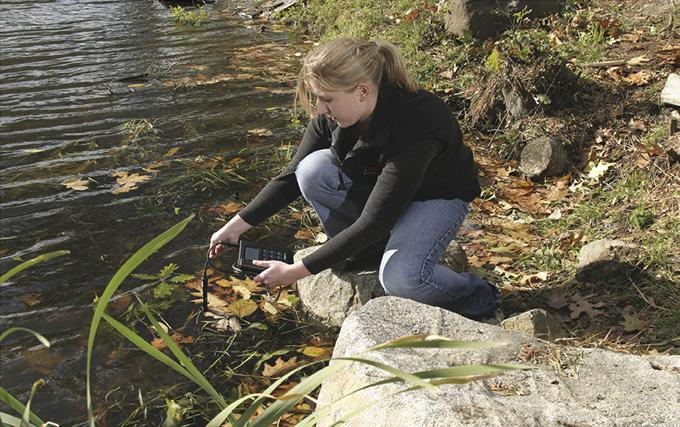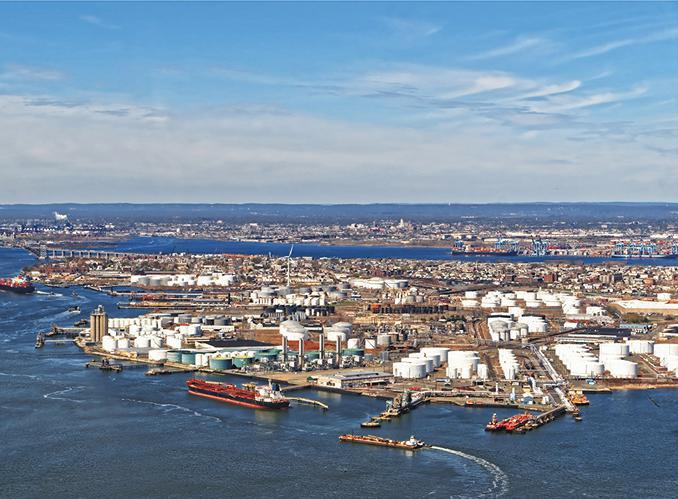The Importance Of Robust Water Management: The Evolving Challenge Of Safeguarding Global Waterways
By Dr. Andrea F. Gullà
As manufacturing across the world further develops, new chemicals and contaminant threats are being introduced into the environment, creating new challenges for industrial and municipal treatment operations.
Access to clean and inexpensive water is something that many of us take for granted in the 21st century. Made possible thanks to a robust water treatment, monitoring, and management infrastructure, it’s only when there’s an issue with the supply that we appreciate the true value of this most basic of necessities.
The recent drinking water crisis in Flint, MI, as well as the ongoing challenges associated with fracking in western Pennsylvania, highlight how disruptive water contamination can be to our quality of life. Yet water contamination has implications that extend far beyond drinking water. Effective water treatment and monitoring are essential for the normal functioning of a wide range of industries, from pharmaceutical manufacturing and food and beverage production, through to global container shipping. Here, we look at some of the water management issues facing these industries and how water treatment and monitoring technologies are helping to tackle these challenges.
Water And The Pharmaceutical Industry
Water management is of great importance to the pharmaceutical industry, where it plays a key role in enabling access to safe and effective medicines. Water is used widely as a solvent, excipient, and reagent in many drug manufacturing processes, and its quality can affect almost every operational aspect in the production of pharmaceuticals, nutraceuticals, and personal care products.
Most pharmaceutical manufacturing plants source their water from municipal supplies. However, impurities such as silica, sodium, and other heavy metal contaminants can affect the ability to develop effective products, damage equipment, and bring production to a halt. Additional treatment processes are therefore required to bring water to a level of quality that gives manufacturers appropriate control over their workflows.
Of course, the role of water treatment in pharmaceutical manufacturing doesn’t stop at the end of the water inflow pipe. To protect the environment and safeguard human health, drug manufacturers have an obligation to treat outgoing wastewater before it is discharged back into the environment. Failure to do so can have serious consequences.
One area of concern is the growing threat from antimicrobial drug resistance. Untreated wastewater from the pharmaceutical industry can contain a complex cocktail of antibiotics, organic matter, and microbes — the perfect breeding ground for bacterial drug-resistance to take hold. Without the appropriate treatment and monitoring processes, these microbes can potentially find their way into municipal supplies where they can end up in drinking water or food products.
Fecal indicator bacteria or total coliform content are generally used to assess water quality. While methods based on these indicators are well-placed to analyze water that may have come into contact with human sewage, they can perform poorly when used to assess water containing industrial pollutants. However, thanks to recent advances in molecular methods and next-generation sequencing, the ability to accurately assess water quality through analysis of waterborne microbial assays has been greatly enhanced. Recent years have seen the development of rapid microbial detection technologies based on molecular, whole-cell, and surface detection methodologies. Here, some of the most important methods include immunoassay techniques, molecular-specific probes, and nucleic acid detection — the latter being particularly effective in sequencing the nature of the bacteria content, viruses, and protozoa. Along with methods based on fluorescence detection, flow cytometry, laser-based interferometry, and fiber optic biosensing, these technologies are well-placed to address the evolving challenges around microbes in our waterways.

Field testing for environmental water contaminants
Drugs In The Water Supply
While there is no questioning the importance of ensuring drug manufacturers fulfill their obligations around discharging wastewater into the environment, few appreciate the impact of pharmaceutical waste generated by consumers and healthcare providers. Every year in the U.S., tons of unused and out-of-date prescription medicines are flushed down toilets or thrown into landfills, where the active ingredients and their byproducts ultimately find their way into the sewage system. Drugs taken by patients can even find their way into waterways following excretion in urine and feces.
However, most municipal treatment plants are simply not designed to eliminate these types of contaminants. Indeed, just half of the prescription drugs present in sewage are thought to be removed by treatment plants, according to a recent report from the U.S. and Canadian International Joint Commission.1 As a result, rising levels of these drugs and their byproducts are being detected in drinking water. While these levels are currently thought to be too low to pose an immediate threat to human health, robust monitoring approaches are essential to ensure that water is safe to use.
The analytical challenges posed by the excretion of drugs differ in many ways from those associated with environmental discharge from pharmaceutical manufacturing. Primarily, this is due to differences in exposure levels, as effects thresholds are independent of the contamination source. Total organic carbon (TOC) and chemical oxygen demand (COD) monitoring are the established standards when it comes to assessing water quality, both at the point of water injection and treatment. While TOC is an analytical measure of the level of organic molecules or contaminants in water, COD gives a measurement relating to virtually all degradable carbon present in water. Ongoing advances in the precision and sensitivity of the technologies used to monitor these indicators are playing a key role in understanding this emerging challenge.

Port Newark in Bayonne, NJ
Pure Water For Food And Beverage Manufacturing
The vast majority of the food and beverages consumed globally contain a significant amount of water, much of which is sourced from municipal supplies. Changes in the quality of this vital ingredient can therefore have a big impact on product safety, quality, and consistency. Access to a consistent supply of water is of critical importance to the soft drinks industry, for example, where products such as sodas typically contain between 89 and 99 percent water.2Ensuring water of sufficiently high quality is used in their manufacture is essential to protect consumer safety. So when water supplies are affected by contamination, rapid action must be taken.
Water supplies in the City of Los Angeles were recently found to contain up to 10 times the permitted level of bromate, a suspected carcinogen formed when ozone used to disinfect drinking water reacts with naturally occurring bromide. Both the U.S. EPA and European Commission have established a regulatory maximum contaminant level of 10 μg/L bromate in drinking water. The discovery of contamination led a major beverage manufacturer to change its water treatment to reverse osmosis at an additional cost. Similar concerns over the presence of elevated levels of bromate in bottled water have been raised in the past, leading to some manufacturers having to pull products from the shelves.3
Ion chromatography plays a key role in the analysis of ozone-treated drinking water. Bromate can be separated using different column chemistries and detected using a variety of techniques, depending on the type of sample and detection limits required. When matrix conditions allow, suppressed conductivity detection is often the simplest method for this purpose. However, alternative strategies, including postcolumn derivatization with UV detection or two-dimensional ion chromatography for matrix elimination, can be used to increase signal and overcome challenges associated with anion interference. As a result, ion chromatography has been proven to be an effective technique for bromate detection and has been validated and approved by the EPA for compliance monitoring.
Of course, access to a consistent supply of clean water isn’t necessary only to safeguard consumer well-being — it’s also important for maintaining brand integrity. In beer production, for example, changes in water quality can significantly affect product taste, smell, and appearance. Brewers have established products with distinct flavors, colors, and odors, underpinned by the use of specific yeasts and ingredients. Yeast activity is highly sensitive to water’s chemical makeup, with pH, hardness, and mineral composition playing a key role in shaping the characteristics of the beer. Any changes in the nature of the water supply can therefore have a sizeable impact on the end product.
Robust monitoring processes are therefore required to ensure product consistency. Low maintenance pH-temperature combination probes have become well-established in food and beverage process applications, as they not only allow simultaneous measurements of pH and temperature, but also require no refilling of the reference solution. However, fast and accurate measurement is not always guaranteed, especially in samples with low ionic strengths. Frequently, this uncertainty arises from the reference system, rather than from the well-established pH sensing element. A homogeneous system based on a redox couple of iodide/ triiodide is often advantageous over heterogeneous systems such as those based on silver/silver chloride redox couples, due to faster rates of equilibration. With accurate monitoring vital to make informed production decisions, advanced monitoring technologies such as these are playing a key role in protecting product safety and quality.
Clean Water’s Role In International Trade
Another industry where safeguarding water quality is of critical importance is international shipping. Container ships play a central role in delivering the goods used on a daily basis. From food to cars, mobile phones to furniture, a vast proportion of the products used by billions of consumers around the world have reached consumers in this way. Indeed, an estimated 1.7 billion metric tons of goods were transported by container ship in 2016, and this figure looks set to increase in coming years.4
Underpinning the safe operation of container ships is ballast — the thousands of liters of water that are pumped aboard cargo-laden vessels to keep them stable at sea. These ballast tanks are regularly filled and discharged from port to port as cargo is loaded and offloaded. Yet ballast isn’t just seawater. It can contain a wealth of biolife, including bacteria, viruses, plants, and small vertebrates, which — unless properly treated — can find their way to ports thousands of miles away from their original home.
If port ecosystems are unable to sustain these new arrivals, aggressive nonnative species can quickly take over. This doesn’t just present a challenge for marine wildlife; changes in biolife such as microbes can have serious consequences for the health of the local human population. Moreover, if carriers and ports fail to meet local regulations around water quality, commercial viability can be threatened. As a result, onboard purification technologies are essential to decontaminate ballast before it is discharged from vessels. These treatment systems are typically based on the use of chlorine (in the form of hypochlorous acid) or dissolved ozone and are designed to reduce levels of contamination to the parts-per-billion level.
Ensuring discharged ballast meets the required quality standards relies on effective monitoring technologies. However, the complex nature of ballast water presents several challenges in terms of analysis. Large particulate contaminants such as silt can interfere with optical analysis approaches, preventing accurate measurement of data. For this reason, ion selective approaches, based on the monitoring of oxidative species, can be a more effective solution, as they are not impacted by water coloration or mixing of contaminants that could create interference by refraction. Moreover, the sensitivity of ion selective systems permits very low limits of detection to be reached, ensuring the quality of discharged water meets the demanding levels required.
An Evolving Global Challenge
Clean water is critical for a wide range of industries, and relies on effective treatment processes. Yet these processes are only as good as the information that’s known about the contaminants present in water. Keeping up with the types of contaminants present in water supplies is a constantly evolving challenge that relies on robust monitoring technologies. Of the 80,000 chemical compounds estimated by the EPA to be in commercial use, only a few thousand have been comprehensively studied for their toxicity. Ongoing development of new chemicals for industry, healthcare, and agriculture means that more unknown chemicals enter global waterways each year. Moreover, with continents such as Asia undergoing rapid industrialization, continued large-scale changes in global water quality will require more innovative water management approaches.
India, for example, is currently undergoing an industrial transformation, as growing numbers of pharmaceutical companies establish manufacturing bases there. Hyderabad is set to become one of the world’s largest bulk drug manufacturing hubs, supplying many of the pharmaceuticals sold in U.S. and European markets. Yet with these economic benefits comes the need to protect water quality and safeguard human health. Recent reports highlight concerning levels of pharmaceutical contaminants in local waterways.5 In a country of over 1.3 billion inhabitants, where up to 80 percent of surface water is contaminated by biological, toxic, organic, and inorganic pollutants, strong water management infrastructure is essential.
China has also undergone rapid industrial development over the past two decades, with double-digit growth figures for many years running. The country is now one of the world’s leading suppliers of rare earth metals, vital for the digital technologies the global population is now so reliant upon, as well as those such as solar panels that will play a key role in meeting the world’s future sustainable energy needs. However, Chinese waterways and municipal supplies now contain high levels of contaminants such as arsenic, chromium, nitrates, and phosphates. Many of these species can reside within the body for very long periods of time and have been linked to a wide range of serious health conditions, including cancer and dementia.
Issues of water management are highly dependent on geographic region and local infrastructure; there is no one-size-fits-all solution to the challenge of water management. Progress will require close cooperation among industry, government, regulators, and technology developers to come up with water management solutions that are specific to the needs of individual regions. Forward-looking companies are working with Chinese partners to put in place monitoring technologies such as COD analyzers, as well as ammonia and phosphate systems, to more fully understand the issues facing global waterways. Armed with the right information about what exactly is present in water supplies, it is hoped that governments will then be able to make informed decisions when it comes to introducing regulations designed to safeguard water quality.
Moreover, current research into the development of total residual oxygen (TRO) technologies could help businesses across a wide range of industries, including pharma, make the right decisions around water treatment. Such novel technologies could allow manufacturers to understand water quality at every stage of use, guiding the removal of contaminants before water is used in production processes and discharged to the environment. Ultimately, improved monitoring technologies could help local municipalities carry out the final treatment steps, ensuring safe, clean waterworks for everyone within the water cycle.
Conclusions
Water treatment plays an important role in a wide range of industries, from pharmaceutical production to food and beverage manufacturing and global shipping. Treatment technologies are essential for safeguarding consumer well-being, protecting the environment, and ensuring businesses remain financially viable. However, in a world where new contamination threats can rapidly emerge, it’s vital that manufacturers, municipal water providers, and regulators have the monitoring technologies they need to identify constantly evolving water chemistries. Safe and adequate freshwater resources are central to the health of the global economy and communities around the world. Without understanding the nature of the challenge, it won’t be easy to implement effective solutions.
References
- B. Bienkowski, “Only Half of Drugs Removed by Sewage Treatment,” Scientific American, 2013. [Online]. Available: http://www.scientificamerican.com/article/ only-half-of-drugs-removed-by-sewage-treatment/.
- Coca-Cola, “Why water is one of The Coca-Cola Company’s most important ingredients.” [Online]. Available: https://www.coca-cola.co.uk/stories/why-water-isone- of-our-most-important-ingredients.
- C. Mercer, “US: Bottled water pulled in bromate scare,” 2006. [Online]. Available: https://www.beveragedaily.com/Article/2006/08/14/US-Bottled-water-pulled-inbromate-scare.
- Statistica, “Container Shipping - Statistics & Facts.” [Online]. Available: https:// www.statista.com/topics/1367/container-shipping/.
- Changing Markets Foundation, “Hyderabad’s pharmaceutical pollution crisis: Heavy metal and solvent contamination at factories in a major Indian drug manufacturing hub,” 2018.
About The Author
 Dr. Andrea F. Gullà is the R&D director of the Thermo Fisher Scientific Water and Laboratory Products business. He has a Ph.D. in physical chemistry with a minor in computational chemistry from Northeastern University. Dr. Gullà holds several international patents spanning multiple fields of study, including water remediation. His current focus areas are novel functionalized materials and sensing technologies for water analysis and purification.
Dr. Andrea F. Gullà is the R&D director of the Thermo Fisher Scientific Water and Laboratory Products business. He has a Ph.D. in physical chemistry with a minor in computational chemistry from Northeastern University. Dr. Gullà holds several international patents spanning multiple fields of study, including water remediation. His current focus areas are novel functionalized materials and sensing technologies for water analysis and purification.
